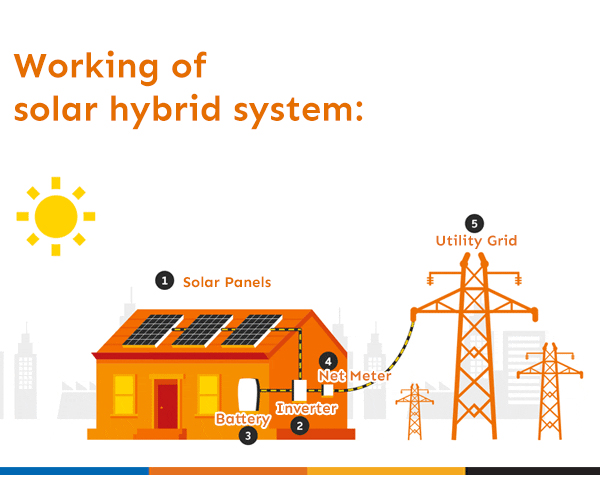What is a Hybrid Solar Power System?
Off-grid systems work independently of the grid but have batteries which can store the solar power generated by the system. The system usually consists of solar panels, battery, charge
controller, grid box, inverter, mounting structure and balance of systems. The panels store enough sunlight during the day and use the excess power generated in the night.
It comes with the advantage of storing energy in the battery when the solar panel operates at its peak and retrieving the stored energy during peak evening hours when electricity rates
are high or in case of any grid failure. Also, one can sell the surplus energy generated to the local grid-connection and get paid for the same.
Components of the hybrid solar system
A hybrid energy system combines the on-grid and off-grid components. The following components are used while installing the hybrid solar system at your home or a
commercial location:
-
Solar Panel: Solar panel forms the base of the solar energy system without this the powerful solar radiations cannot be extracted and used. The solar radiation in the form
of photons falls on the solar panel and generates electricity in the form of DC energy.
-
Direct Current Distribution Box(DCDB): DCDB is a combiner box, its primary function is to combine the multiple strings of solar panels into one. This box consists of
protection components such as a miniature circuit breaker(MCB), fuse and surge protection device.
-
Charge Controller: This component is assembled with the battery to control the amount of charge streaming into the battery. The major task of the controller is to regulate
the flow of charges and prevent the battery from over or undercharging, thus increasing the lifespan of the battery.
-
Hybrid Inverter: The inverter is an essential component of the solar energy system, it helps in converting the generated DC energy from the solar panel or battery into
usable AC energy.
The inverter offers monitoring of the energy spent, received, consumed or stored in the battery; it helps in monitoring the performance of the solar panel as
well as the battery.
-
Alternating Current Distribution Box (ACDB): The primary function of the ACDB is to protect the appliances from any fault that occurs in the hybrid inverter,it consists of
protective appliances such as a miniature circuit breaker(MCB), fuse and surge protection device.
-
Batteries: For off-grid and hybrid solar systems, batteries play an important role to store the surplus energy produced during the sunny day and is retrieved later during
cloudy weather or night when the solar panel is not able to produce a sufficient amount of power. For renewable energy systems, rechargeable batteries such as lithium or lead-acid
batteries are recommended.

Working of solar hybrid system
When solar radiations in the form of photons are incident on the solar panel, direct current(DC) is generated using the photovoltaic principle. The DC energy generated depends on
the solar radiation intensity.
- This generated DC energy is fed into the charge controller which helps in regulating the amount of power to be supplied to the battery.
- Depending on the power requirement by different appliances, the inverter draws energy from these batteries and converts it into a usable alternating current.
- This generated AC energy is supplied to different loads through the wiring system.
- When the battery is fully charged then the solar panel supplies the surplus generated DC power through the inverter and net meter to the utility grid-connected and gets paid
for this surplus power.
- The stored energy in the battery is retrieved during the non-sunny day or at night depending on the requirement.
Advantages
- Reduced grid dependency
- Hybrid inverters come with backup power capacity thus providing uninterrupted power under any circumstances. It allows consumers to consume power from grid, battery or solar.
- It can be used as an off-grid solar energy system in case of power failure.
- Can retrieve stored energy during cloudy weather or peak evening time (when tariff rates are high) thus saving the electricity bills
Disadvantages
What happens when a power outage occurs?
- Higher and complex installation cost
- Increase maintenance costs due to periodical replacement of batteries.
- Backup power build only for running critical loads, support is not provided to all the appliances.
What happens when a power outage occurs?
During daytime when the solar panel is in operation and suddenly if the grid failure occurs the solar power system won’t shut down. Instead, the system will isolate the grid supply and
switch on to the battery system, it will retrieve the required power for all the appliances from the battery stored energy.
During the power outage, one must take care that the power consumed by all the appliances must be less than the inverter wattage.
Note: In a hybrid energy system when a solar panel is not capable of generating sufficient power during the cloudy day to cater power to all the loads, the system draws
the power from the utility grid-connected and needs to pay only for that consumed electricity. In the event during sunny days when the solar panel produces more power
than required by the load, the surplus power can be supplied to the utility grid and can get paid for the same.


